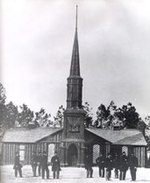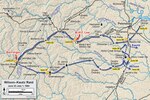Battle of Vaughan Road
The Battle of Vaughan Road, also spelled "Vaughn", was an American Civil War engagement between Confederate States Army and Union Army cavalry forces protecting the flank of the main Union attack on Confederate positions on the western end of the Confederate line on October 1, 1864 during the Battle of Peebles' Farm, part of the Siege of Petersburg. The Union force repulsed Confederate attacks and protected ground just gained at McDowell's Farm and an important road junction on the Vaughan Road at the Wyatt Road. They inflicted about 130 casualties on the Confederates while losing about 90 men, about half of whom were taken prisoner. During the battle, Confederate Brigadier General John Dunovant was killed. Union Army Sergeant James T. Clancy, who was awarded the Medal of Honor on July 3, 1865, was credited with firing the fatal shot. In the overall actions on September 29, 1864, through October 2, 1864, the Union force suffered about twice as many casualties as the Confederate forces but both sides lost about the same percentage of their forces. The Union forces took some key positions and forced the Confederates to extend their increasingly thinly manned lines of defense at Petersburg, Virginia, and Richmond, Virginia. They did not achieve all of their objectives and did not cut the Boydton Plank Road which was a vital Confederate supply line.
Excerpt from the Wikipedia article Battle of Vaughan Road (License: CC BY-SA 3.0, Authors).Battle of Vaughan Road
Vaughan Road,
Geographical coordinates (GPS) Address Nearby Places Show on map
Geographical coordinates (GPS)
| Latitude | Longitude |
|---|---|
| N 37.131666666667 ° | E -77.453888888889 ° |
Address
Vaughan Road 10201
23805
Virginia, United States
Open on Google Maps










